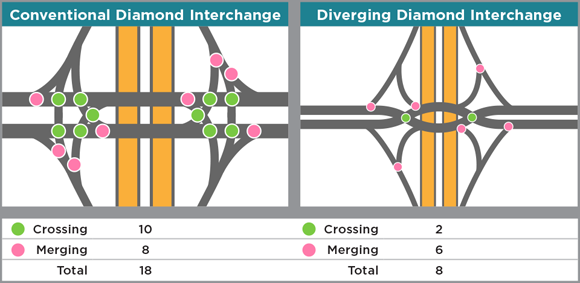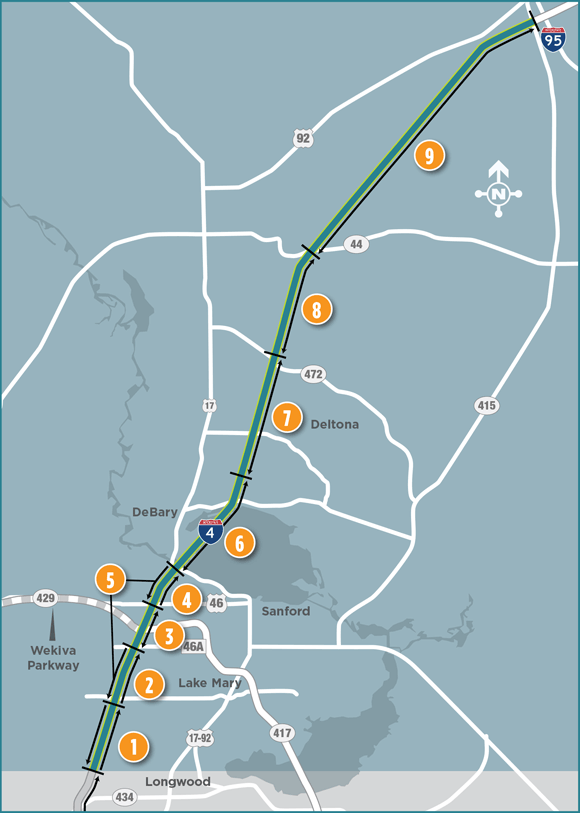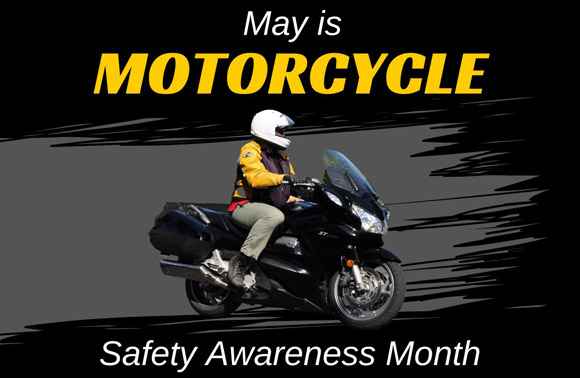How Diverging Diamond Interchanges Reduce Conflict Points

|
| A major safety benefit of a diverging diamond interchange (DDI) is that it’s been proven to significantly reduce collisions. In the signalized intersection depicted above, converting to a DDI reduces the number of conflict points from 18 to 8. |
| |
Diverging diamond interchanges (DDIs) are coming to three locations along Interstate 4 (I-4) in Orange County and Osceola County. These innovative interchanges are designed to improve both safety and traffic flow over more traditional interchanges.
One of the primary safety features of a DDI is the significant reduction of conflict points.
A conflict point is any location in the interchange where vehicles’ paths merge, diverge, or cross. These are the most likely locations for collisions to occur. Crashes that take place at conflict crossing points are more likely to be more serious than at merging conflict points.
A conventional diamond interchange typically has 10 crossing conflict points and eight merging conflict points. A DDI, however, has only two crossing conflict points and six merging conflict points. This reduction of 10 conflict points is achieved by shifting traffic temporarily to the opposite side of the road.
Motorists approaching the freeway from either direction on the surface road switch sides at a traffic signal prior to the left-hand interstate entrance ramp, allowing them to turn left onto the ramp without crossing in front of opposing traffic. The movement to the opposite side of the road also allows safer left turns from the freeway exit ramps onto the surface road, as these former crossing conflict points now become merging conflict points.
In fact, the only two remaining crossing conflict points when an interchange is transformed into a DDI are the two traffic signals — one on each side of the freeway. The road is curved at these points, which tends to reduce the speed of vehicles and severity of collisions.
While the safety improvements built into a DDI cannot eliminate all crashes, these innovative interchanges can drastically reduce the number and severity of crashes by changing the flow of traffic.
With DDI construction starting this summer at County Road 532 and two more on the way — Daryl Carter Parkway in 2022 and Sand Lake Road (State Road 482) in 2023 — drivers will need to be aware of the changes that are coming. However, despite the movement to the left side of the road, the intuitive nature of DDIs makes navigating through them simple.
For more information on DDIs, visit I4Beyond.com/DDI.
|
|
Quiz: Motorcycle Safety Awareness Month
May is Florida’s Motorcycle Safety Month, so if you plan on riding a motorcycle in the Sunshine State, take this quiz to test your knowledge and make sure you’re ready. Afterwards, share the quiz with any family or friends who ride motorcycles to help them stay safe and informed while they’re out on the road!
|
|
Westbound I-4 Milling and Resurfacing in Seminole County Wraps Up

|
| |
| 1 |
2.7 miles of I-4 from east of State Road (S.R.) 434 to west of Lake Mary Boulevard, milling and resurfacing anticipated to be completed in 2021. (FPID No.: 439682-3) |
| 2 |
2.9 miles of eastbound I-4 from west of Lake Mary Boulevard to west of County Road (C.R.) 46A, milling and resurfacing completed in spring 2020. (FPID No.: 439682-2) |
| 3 |
2 miles of I-4 from west of C.R. 46A to S.R. 46 is part of Wekiva Parkway Section 8 project and is anticipated to be completed in 2022. (FPID No.: 240200-4) |
| 4 |
1.8 miles of eastbound I-4 from S.R. 46 to east of U.S. 17-92, milling and resurfacing completed in spring 2020. (FPID No.: 439682-5) |
| 5 |
4.9 miles of westbound I-4 from west of Lake Mary Boulevard to east of U.S. 17‑92 (excluding 2-mile section between C.R. 46A and S.R. 46 for Wekiva Parkway), milling and resurfacing completed in 2021. (FPID No.: 439682-1) |
| 6 |
5.4 miles of I-4 from the St. Johns River bridge to east of Enterprise Road, milling and resurfacing completed in 2017. (FPID No.: 432455-1) |
| 7 |
4.7 miles of I-4 from west of Saxon Boulevard to east of S.R. 472, milling and resurfacing completed in 2018. (FPID No.: 438038-1) |
| 8 |
4.8 miles of I-4 from east of S.R. 472 to S.R. 44 is scheduled for milling and resurfacing in 2021. (FPID No.: 434411-1) |
| 9 |
13.7 miles of I-4 from S.R. 44 to I-95, reconstruction and widening with concrete pavement completed in 2017. (FPID No.: 408464-1) |
|
Listed above are the recent and upcoming resurfacing projects on Interstate 4, north of the I-4 Ultimate project. View or download a handout that outlines all the recent milling and resurfacing projects on I-4 in Osceola, Orange, Seminole and Volusia counties.
|
The Florida Department of Transportation (FDOT) completed the milling and resurfacing of westbound Interstate 4 (I-4) through much of Seminole County this month.
Motorists will enjoy driving on freshly paved westbound I-4 travel lanes from U.S. 17-92 to State Road (S.R.) 46 and from County Road (C.R.) 46A to Lake Mary Boulevard, along with the interchange ramps at Lake Mary Boulevard, C.R. 46A, S.R. 46, and U.S. 17-92. The milling and resurfacing project began in summer 2020.
Crews spent the last few weeks finishing the repaving project, as warmer spring weather allowed the construction team to add the final layer and finishing touches to the new I-4 pavement. When paving, it is important the hot mix asphalt pavement does not cool too quickly. Crews monitor the ground and ambient temperatures to ensure it is at least 40 degrees and rising.
The milling and resurfacing of the eastbound I-4 travel lanes and interchange ramps was completed in summer 2020, meaning motorists will be able to travel through much of Seminole County on a completely repaved I-4 in both directions.
Both directions of I-4 between C.R. 46A and S.R. 46 will be repaved as part of the Wekiva Parkway Section 8 extension, which began construction in fall 2019.
To keep the ride on I-4 smooth, periodic milling and resurfacing of the asphalt is important to make repairs that can lengthen the lifespan of the road. Resurfacing is necessary when the asphalt surface has reached the end of its service life or if other methods of restoration cannot repair the roadway. A new asphalt surface will improve driving conditions as well as the aesthetics of the roadway.
Two new I-4 milling and resurfacing projects are scheduled to begin later this year at:
- West of Orange Camp Road (C.R. 4139) to S.R. 44; and
- From the Polk-Osceola county line to west of S.R. 417.
View or download a handout that outlines all the recent milling and resurfacing projects on I-4.
|
|
Beyond the Ultimate Spotlight:
Robert Singleton, Construction and Engineering Inspection
After 30 years in construction, Robert Singleton still likes new challenges no matter how hard or high the obstacle.
As an inspector for Elipsis Engineering, he is reviewing and documenting the installation of the Wrong Way Vehicle Detection Systems on Interstate 4 (I-4).
Previously, he was an ironworker who traveled the southeast for 20 years, working on commercial buildings, bolting, and riveting steel girders into place. “I liked the work and that I could move up,” Singleton said.
There was one problem, though. For an ironworker, moving up didn’t just mean a promotion or better pay. Many times it meant working 10 stories or more above ground. “I always wanted to do better and move up,” he said. “But I do not like heights. I have a fear of heights.” Nonetheless, he often found himself 150 feet up in the air, moving along 8-inch-wide steel beams like a tightrope walker.
How did he deal with it? Never look down? Try to ignore it. Personal pep talks? “No, you have to respect it,” he said. “Respect it and respect your safety gear. Make sure your safety lines are tied off. Know where you are. Know where you’re stepping. Plan ahead. Then, do your job.”
Singleton doesn’t say he conquered his fear. But he faced it, controlled it, and planned ahead. That strategy served him well when he heard from a friend in Central Florida about a chance to learn how to inspect construction work. Having grown up in Pensacola, and weary of traveling, he was glad to return to Florida.
Ten years later, he has earned several professional certifications and is proud to be inspecting the Wrong Way Vehicle Detection System project that will install high-tech detection and alert systems on I-4. “This is so important. It’s going to save lives,” he said.
Away from work, Singleton enjoys riding dirt bikes and jet skis with his wife, family, and friends. Leisure time is one of the benefits of not constantly traveling to find the next ironworking job.
“I love my current job,” he said. “I can work and take care of my family with my feet planted on the ground.”
|
|
|







